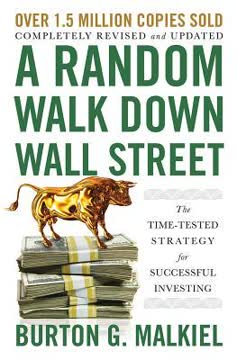Key Takeaways
1. Behavioral finance is the key to successful investing
"Psychology seems to lie behind all the ways that potentially improve stock market returns."
Understanding human behavior is crucial for successful investing. Behavioral finance examines how psychological factors influence investors' decisions and market outcomes. This field reveals that investors often act irrationally, driven by emotions like fear and greed, leading to systematic errors in judgment.
Common behavioral biases include:
- Overconfidence: Overestimating one's abilities
- Confirmation bias: Seeking information that supports existing beliefs
- Loss aversion: Feeling losses more strongly than equivalent gains
- Herding: Following the crowd rather than independent analysis
By recognizing these biases, investors can develop strategies to counteract them, leading to better decision-making and improved returns. This self-awareness is often more valuable than complex financial models or market predictions.
2. Consistency trumps complexity in investment strategies
"Consistency is the last refuge of the unimaginative."
Simple, consistent approaches often outperform complex strategies in investing. While financial markets are intricate, successful investing doesn't require elaborate models or constant activity. Instead, adhering to a straightforward, rules-based approach can yield superior results over time.
Key elements of a consistent investment strategy include:
- Regular contributions to investments
- Periodic rebalancing of portfolios
- Sticking to a predefined asset allocation
- Avoiding knee-jerk reactions to market volatility
This approach helps investors avoid common pitfalls such as market timing and overtrading, which often lead to underperformance. By focusing on consistency, investors can harness the power of compound interest and long-term market growth, rather than being swayed by short-term fluctuations or trends.
3. Diversification is essential, but conviction is crucial
"Wide diversification is only required when investors do not understand what they are doing."
Balancing diversification and conviction is key to successful investing. While diversification helps manage risk by spreading investments across various assets, excessive diversification can lead to mediocre returns. The goal is to find the sweet spot between risk mitigation and return potential.
Effective diversification strategies:
- Invest across different asset classes (stocks, bonds, real estate)
- Include international investments
- Consider alternative investments for further diversification
However, it's equally important to maintain conviction in your investment choices. This means having a thorough understanding of your investments and the confidence to maintain positions even during market turbulence. A focused portfolio of 25-50 stocks can provide sufficient diversification while allowing for meaningful outperformance.
4. Market timing is futile; focus on time in the market
"Far more money has been lost by investors preparing for corrections or trying to anticipate corrections, than has been lost in corrections themselves."
Long-term investing beats timing attempts. Countless studies have shown that consistently predicting market movements is virtually impossible, even for professional investors. Instead of trying to time the market, investors should focus on maximizing their time in the market.
Benefits of long-term investing:
- Captures the overall upward trend of markets
- Reduces transaction costs and taxes
- Allows compound interest to work its magic
- Minimizes the impact of short-term volatility
By staying invested through market cycles, investors can benefit from the long-term growth of the economy and corporate earnings. This approach also helps avoid the costly mistakes often associated with emotional decision-making during market highs and lows.
5. Valuation is the cornerstone of risk management
"Well bought is half sold."
Paying attention to valuation is crucial for managing investment risk. Overpaying for assets, regardless of their quality, can lead to poor returns or significant losses. By focusing on valuation, investors can create a margin of safety that helps protect against downside risk.
Key valuation metrics to consider:
- Price-to-earnings ratio (P/E)
- Price-to-book ratio (P/B)
- Price-to-sales ratio (P/S)
- Free cash flow yield
Valuation-based investing often requires patience and discipline, as it may mean avoiding popular but overpriced investments. However, this approach has historically led to superior risk-adjusted returns over long periods. Remember, the price you pay determines your future returns.
6. Quality matters: Seek businesses with sustainable advantages
"You have to be able to play out your hand under different circumstances."
Investing in quality businesses with sustainable competitive advantages is crucial for long-term success. These companies, often referred to as having "economic moats," can maintain high profitability and growth even in challenging economic conditions.
Characteristics of quality businesses:
- Strong brand recognition
- High barriers to entry
- Network effects
- Economies of scale
- Proprietary technology or patents
By focusing on quality, investors can reduce the risk of permanent capital loss and increase the likelihood of compounding their wealth over time. Quality businesses tend to be more resilient during economic downturns and can often emerge stronger, taking market share from weaker competitors.
7. Momentum investing can enhance returns when combined with value
"Every trend goes on forever, until it ends."
Combining momentum and value strategies can lead to superior returns. While value investing focuses on buying underpriced assets, momentum investing seeks to capitalize on existing market trends. By integrating these approaches, investors can potentially enhance returns while managing risk.
Key aspects of momentum investing:
- Analyzing price trends over 6-12 month periods
- Focusing on relative strength compared to other stocks
- Considering both absolute and relative momentum
When combined with value criteria, momentum can help identify undervalued stocks that are beginning to be recognized by the market. This approach can lead to better entry and exit points, potentially improving overall portfolio performance.
8. Insider activity and dividends signal management confidence
"You don't become a value investor for the group hugs."
Pay attention to insider actions and dividend policies as they often signal management's confidence in the company's prospects. Insider buying, share buybacks, and consistent dividend growth can be positive indicators of a company's financial health and future prospects.
Signs of management confidence:
- Significant insider purchases
- Share buyback programs
- Consistent dividend increases
- High insider ownership
These actions demonstrate that management believes in the company's value and is willing to put their money where their mouth is. However, it's important to consider these factors in conjunction with other fundamental and valuation metrics for a comprehensive analysis.
9. Emotional discipline is crucial for long-term success
"Investing is simple, but not easy."
Mastering your emotions is perhaps the most critical skill for successful investing. The biggest obstacle to investment success is often the investor's own behavior, driven by fear, greed, and other emotions that can lead to poor decision-making.
Strategies for maintaining emotional discipline:
- Develop and stick to a written investment plan
- Avoid checking your portfolio too frequently
- Practice mindfulness and self-awareness
- Learn from past mistakes and market history
By maintaining emotional discipline, investors can avoid common pitfalls such as panic selling during market downturns or chasing performance during bull markets. This discipline allows for better adherence to long-term strategies and can lead to superior returns over time.
10. Automated processes help overcome behavioral biases
"The best thing to do is often, but not always, nothing."
Implementing automated processes can help investors overcome behavioral biases and stick to their investment strategies. By removing emotion from day-to-day investment decisions, automation can lead to more consistent and potentially better outcomes.
Examples of automated investment processes:
- Regular, automatic contributions to investment accounts
- Systematic rebalancing of portfolios
- Rule-based buying and selling criteria
- Dollar-cost averaging into positions
Automation helps enforce discipline and reduces the impact of emotional decision-making. It also takes advantage of beneficial practices like regular investing and rebalancing, which can be psychologically difficult to maintain manually. By leveraging automation, investors can focus on their long-term goals rather than being swayed by short-term market movements.
Last updated:
FAQ
What's The Laws of Wealth about?
- Behavioral Finance Focus: The Laws of Wealth by Daniel Crosby explores how psychology intersects with investing, focusing on how human behavior impacts financial decisions.
- Two-Part Structure: The book is divided into two parts: self-management rules and behavioral asset management strategies, providing both psychological insights and practical tools.
- Real-World Applications: Through anecdotes and research, Crosby illustrates how understanding behavioral finance can lead to better investment outcomes by recognizing biases and developing a disciplined approach.
Why should I read The Laws of Wealth?
- Improved Investment Decisions: The book helps readers understand psychological barriers to effective investing, allowing for more informed decisions.
- Practical Framework: Crosby offers a straightforward framework for managing investments through behavioral self-management, enhancing strategies and potentially increasing returns.
- Engaging and Accessible: The writing is engaging and humorous, making complex concepts in behavioral finance accessible to a broad audience.
What are the key takeaways of The Laws of Wealth?
- Ten Behavioral Rules: The book presents ten essential rules for managing investor behavior, such as "You Control What Matters Most."
- Behavioral Risk Management: Crosby introduces the concept of behavioral risk, emphasizing the importance of understanding this risk for successful investment strategies.
- Long-Term Focus: Emphasizes maintaining a long-term perspective, especially during market volatility, as a psychological price for strong returns.
What are the best quotes from The Laws of Wealth and what do they mean?
- "You are not special.": Highlights the common overestimation of abilities among investors, encouraging a disciplined approach.
- "If you’re excited, it’s a bad idea.": Warns against impulsive investment decisions driven by emotions, advocating for calm and rationality.
- "This too shall pass.": Reminds investors that market highs and lows are temporary, encouraging focus on long-term goals.
What is the Rules Based Investing (RBI) method mentioned in The Laws of Wealth?
- Behavioral Framework: RBI is a systematic approach incorporating behavioral finance principles to mitigate emotional biases in investment decisions.
- Focus on Consistency: Emphasizes the importance of consistently applying investment strategies, regardless of market conditions.
- Combining Strategies: Advocates for blending active and passive strategies within the RBI framework to benefit from both approaches.
How does The Laws of Wealth address emotional investing?
- Emotions as Barriers: Emphasizes that emotions can cloud judgment and lead to poor investment decisions, highlighting the need for emotional regulation.
- Practical Strategies: Offers tips for managing emotions, such as exercising and labeling feelings, to maintain clarity during market fluctuations.
- Long-Term Perspective: Encourages focusing on long-term goals rather than short-term emotional reactions to navigate market volatility.
What are the ten rules of behavioral self-management in The Laws of Wealth?
- Rule #1: You Control What Matters Most: Emphasizes that behavior is the most significant factor in investment success.
- Rule #2: You Cannot Do This Alone: Highlights the importance of seeking help from advisors or peers to manage biases.
- Rule #3: Trouble Is Opportunity: Encourages viewing market downturns as opportunities to buy quality assets at lower prices.
How does The Laws of Wealth define risk in investing?
- Risk as Permanent Loss: Defines risk as the possibility of permanent loss of capital rather than volatility, focusing on long-term security.
- Behavioral Risk: Introduces behavioral risk, emphasizing the potential for actions to lead to financial losses.
- Long-Term Focus: Advocates for maintaining a long-term perspective to manage risk and avoid impulsive decisions.
What is the significance of diversification according to The Laws of Wealth?
- Risk Management Tool: Presents diversification as a key strategy for managing investment risk by spreading investments across asset classes.
- Historical Evidence: Cites data showing diversified portfolios tend to outperform concentrated investments over time.
- Emotional Benefits: Highlights psychological benefits, as diversification can reduce emotional stress during market volatility.
What is Rule-Based Behavioral Investing (RBI) in The Laws of Wealth?
- Framework for Decision-Making: RBI is a structured approach to reduce emotional and cognitive biases in investment decisions.
- Four Key Principles: Consists of Consistency, Clarity, Courageousness, and Conviction, guiding disciplined investment strategies.
- Mitigating Behavioral Risks: Helps manage emotions and avoid pitfalls like panic selling or trend chasing.
How does The Laws of Wealth define loss aversion?
- Emotional Impact of Loss: Describes loss aversion as the phenomenon where losses are felt more intensely than equivalent gains.
- Behavioral Consequences: Explains how loss aversion can lead to holding losing investments too long and selling winners too quickly.
- Strategies to Overcome: Suggests setting predefined exit points and focusing on long-term goals to combat loss aversion.
What are the Four Cs of RBI in The Laws of Wealth?
- Consistency: Stresses sticking to a predetermined strategy to avoid emotional decision-making.
- Clarity: Involves focusing on evidence-based factors and avoiding market noise.
- Courageousness: Encourages taking non-consensus views and remaining invested during volatility.
- Conviction: Emphasizes having a diversified portfolio reflecting beliefs and market understanding.
Review Summary
The Laws of Wealth receives mostly positive reviews for its insights on behavioral finance and investing psychology. Readers appreciate Crosby's practical advice, engaging writing style, and focus on investor behavior as a key factor in wealth creation. The book is praised for its mix of psychological concepts and real-world investing applications. Some criticize repetitiveness and oversimplification, while others find it an essential read for both novice and experienced investors. Overall, reviewers recommend it as a valuable resource for understanding and improving investment decision-making.
Similar Books










Download PDF
Download EPUB
.epub digital book format is ideal for reading ebooks on phones, tablets, and e-readers.




